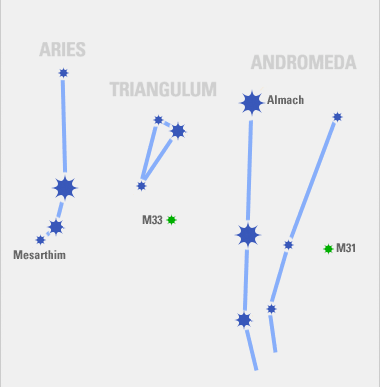

Triangulum is well placed at this time of year for observations of M33, a spiral galaxy. However, at 2.4 million light years and only 5% as massive as our own galaxy, it's a dim fuzzy object in 8" scopes and requires good dark skies to show any detail.
Follow a line from M33 through Mirach in Andromeda to find the brightest spiral in the sky, M31, the Andromeda Galaxy as well as its satellite galaxies M32 and M110. As with M33, the photons from M31 have travelled 2.4 million years to pass through the pupil of your eye and end their journey on your retina. The Andromeda Galaxy is also one of the few galaxies that's blue-shifted, meaning that is traveling toward us: almost all others are red-shifted and speeding away. Once you've found M31 with the aided eye, you can practice picking it out with the naked eye. You can then congratulate yourself that no-one can see any farther than you; the barely visible faint smudge you can just make out is the farthest object visible to the unaided eye.
At the tip of the constellation's brightest limb, is Almach (Gamma Andromedae) a very sweet orange/blue double. And finally, below Triangulum, in Aries, is Mesarthim (Gamma Aries) another lovely double, orange/green, sitting 207 light years away with an angular separation of 7.5".
October 2006















